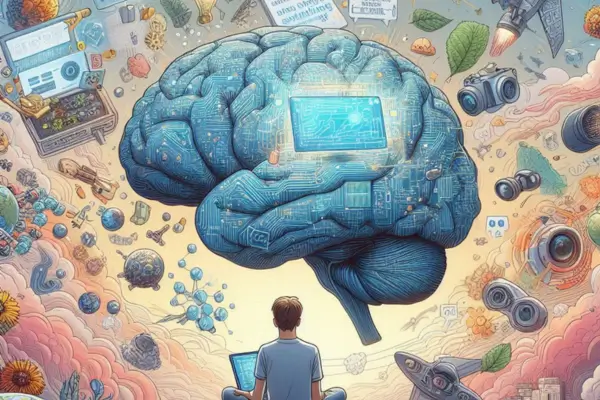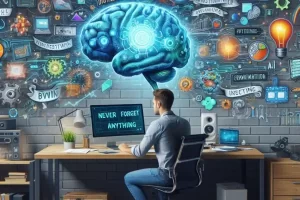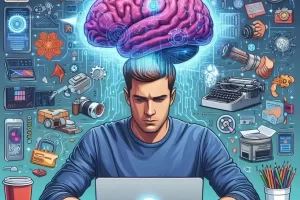In a world where information never stops — emails, articles, podcasts, videos, notifications, courses, social media — it’s easy to feel overwhelmed. Most of us are drowning in content and starving for clarity. But when you build a second brain, enhanced by artificial intelligence (AI), you gain a system that helps you filter, focus, and use information instead of being buried by it.
In this article, you’ll learn how to manage information overload using your second brain and AI — so you stay informed without feeling overwhelmed.
Why Information Overload Is a Modern Productivity Crisis
We live in the “too much era”:
- Too many things to read
- Too many tasks to do
- Too many ideas to remember
- Too many apps and tabs open
This leads to:
- Decision fatigue
- Shallow thinking
- Lost insights
- Constant distraction
But it’s not the volume of information that’s the problem — it’s the lack of systems to manage it.
Define What Information Matters
You don’t need more input — you need better filters.
Start by asking:
- What areas of knowledge actually move me forward?
- What information do I need for my current projects or goals?
- What content sources do I trust and value?
Use AI to help:
“Summarize my recent highlights and identify recurring themes.”
“Which sources have provided the most useful insights in the last 30 days?”
“What topics should I ignore for now based on my current goals?”
Now your second brain filters out noise and amplifies signal.
Create a Low-Friction Capture System
Information becomes overwhelming when you try to process everything at once. Instead, build an inbox system.
Use tools like:
- Readwise (for highlights from Kindle, Twitter, articles)
- Notion web clipper or Obsidian quick notes
- Voice notes with Otter.ai
- Zapier automations (e.g., save starred emails to your second brain)
Then use AI to clean and classify:
“Summarize these 10 new captures.”
“Group these highlights by theme or topic.”
“Which of these notes need further attention?”
This keeps your second brain organized at the input stage.
Prioritize What to Process and Keep
You don’t need to process everything. Use AI to help you triage.
Prompt examples:
- “Which notes in my inbox are most relevant to my current project?”
- “What can I archive or delete from this list?”
- “Which articles are worth turning into evergreen knowledge?”
Let your second brain act like a mental editor, deciding what stays and what goes.
Turn Input Into Insight
The goal isn’t to collect information — it’s to transform it into understanding.
With AI, you can:
- Summarize long content
- Pull out actionable takeaways
- Translate complex ideas into simple terms
- Link new knowledge to existing concepts in your second brain
Prompts:
“Summarize this 2,000-word article into 3 takeaways and 1 action step.”
“What does this idea have in common with my notes on productivity?”
“Explain this concept like I’m five years old.”
Now your second brain is digesting information for you.
Review Smartly — Not Constantly
You don’t need to constantly revisit everything you’ve saved. You need timely reminders.
Set up review systems using:
- Spaced repetition (via Readwise or Notion reminders)
- Weekly or monthly AI-generated summaries
- A “resurface” tag for ideas to revisit later
Let AI help:
“What ideas haven’t I reviewed in 60 days?”
“Which notes should I revisit this week based on my goals?”
“Remind me of 3 ideas I marked as important last month.”
This prevents your second brain from becoming a digital junk drawer.
Build Output-Focused Habits
To stay ahead of overload, aim to use what you learn, not just store it.
Use AI to:
- Turn notes into blog posts, emails, or videos
- Generate outlines and action plans
- Extract decision-making frameworks
- Create content calendars based on past insights
Prompts:
“Based on these 10 ideas, create 5 newsletter topics.”
“Turn this collection of highlights into a client-facing report.”
“What lessons from my recent research can I apply to my business this week?”
Now your second brain becomes a creative and strategic engine.
Periodically Clean and Declutter
Information overload often builds up because we never go back to clean.
Schedule a quarterly system review. Use AI to:
- Identify duplicates
- Archive irrelevant notes
- Merge similar entries
- Suggest system improvements
Prompt examples:
“Which pages haven’t been opened in 90+ days?”
“What tags are being overused or misused?”
“Suggest how I can simplify my folder and tag system.”
This keeps your second brain light, fast, and useful.
Real-Life Example: The Intentional Learner
Let’s say you’re a busy professional consuming a lot of content.
With your AI-enhanced second brain:
- You highlight articles and books in Readwise
- AI summarizes and syncs key ideas into your Notion dashboard
- Every Friday, AI suggests which insights to revisit or expand
- You use AI prompts to turn notes into tweets, blog posts, and action plans
- Once a month, you clean your inbox with AI’s help, keeping only what adds real value
You’re not overwhelmed anymore — you’re empowered.
Final Thoughts: You Don’t Need to Know Everything
In an age of endless information, the skill isn’t knowing more — it’s managing better.
With a second brain and AI, you can:
- Filter out noise
- Focus on what matters
- Convert learning into doing
- Stay organized without spending hours sorting notes
You don’t need more tabs open. You need a smarter way to think.
Let your second brain and AI give you clarity, calm, and control — even in the chaos.




